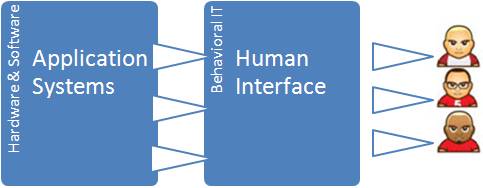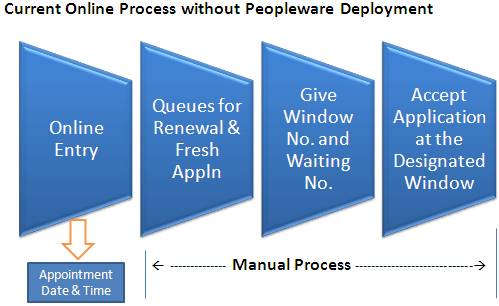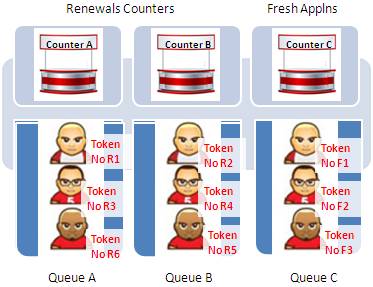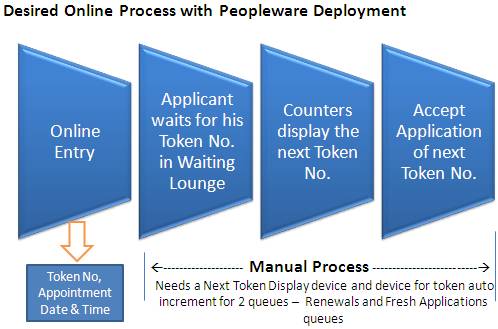|
Story of my painful (and a bit funny) experience with the govt's
Automated Passport System having poor Peopleware Deployment
Update:
This article was written before the new system of "Passport Seva Kendra" by
Tata Consultancy Services (TCS) was
introduced by the Indian Passport Office. The new system more-or-less follows
the peopleware deployment process prescribed in the article below.
Summary
Deployment planning is normally limited to deployment of Hardware and Software
infrastructure, and the related training to IT and user folks. There
is a third deployment planning which
is required which I call Peopleware Deployment. This story of my painful
(and rather funny) experience demonstrates through a real-life example what
is Peopleware Deployment.
Peopleware Deployment involves deployment of people and non-IT equipment, infrastructure
and facilities so that the new system can be effectively used by
people. In this 'case-story' (as it is more of a story than a
case-study), the deployment planning was not done and
hence the case shows how the system is a complete failure without
peopleware deployment planning. The entire effort of automation yields
no benefit to the end-user. The implementation is a flop. The case
is of Passport office.
Contents
Need for Peopleware Deployment
Web Presence of Passport Office
The Commotion at Passport Office
New Wine Old Bottle
The Waiting Game
What Benefit of the Automated System?
What Peopleware Deployment Should have been Planned?
Conclusion
Need for Peopleware Deployment
Most IT Professionals focus only on designing the technology automation
part of a system and not much effort is put on redesigning the manual
interface - or the way people interact with the new automated system. I
call it Peopleware deployment.
Deployment planning is limited to Hardware and software deployment. There is a
third deployment planning which is required which I call Peopleware
Deployment. This could involve deployment of people and non IT
related
equipment, infrastructure, facilities to be provided so that the new
system can effectively be used by people. It also involves planning of,
(and training on) the way end-users would use the system, and the changes
in their interface to the new system.

In the diagram, therefore, I have drawn an applications box and a human
interface box which needs equal attention if not more. However
efficient and attractive may be your technical system, it does not
yield the desired benefit to humans unless the human interface is
redesigned or effective peopleware deployment is done. (You may notice
the Behavioral IT title in the second box. Peopleware planning should
also include a training on Behavioral IT® skills to leadership.
Click here to know more.)
I will take a real life situation - a case story of how automation
without the emphasis on peopleware deployment creates confusion and
waste of all the effort which was put in the development of the solution.
It is the real story of my experience (rather pathetic, a bit funny)
as a user of automation in a public utility service - the passport office.
I had got my own passport renewed through an agent a few years back. At
that time, I knew it was a complex process to renew passports and hence
I did not have the courage to do it myself - I took safe recourse to
the services of a travel agent. Now several years later, my wife's
passport was expiring. Since I had to register a change in address
during renewal, I started surfing the net to read and understand the
address change rules. While surfing the net I was pleasantly surprised
to see what looked like glimpses of automation at the passport office: how the
passport office had made progress in customer relations
/ customer interaction and set up a site for customer information. To
top it all, it was even more pleasant surprise to see that there was
actually an on-line form to apply for passport renewal. Clear
instructions were there to fill up the form along with a list of
supporting documents to submit along with the application. I was
impressed. To see progressive thinking in terms of automation for
better customer service was almost unknown in most Indian government offices.
So I thought India had really progressed in the last few years in terms
of web presence since I last renewed my own passport through the agent.
Web Presence of Passport Office
I was impressed to see automation where you could do self service. So I
was attracted to fill up the form myself. I filled up the form and hit
the submit button. Lo and behold, a bigger surprise was in store for
me! As soon as I submitted the form, I was given an
appointment with
the passport office with Date and Time. TIME too!. Wow, which means (I
presumed) that I don't need to stand in long queues starting from 4am in
the morning. All I had to do was to walk in at the designated time on
that date and happily walk away after presenting my application! What progress
my country had made in the last few years, I thought, with automation of
passport issuance process!
When such great automation was there, I was emboldened to do it myself and
not engage an agent for renewal process. I decided to do it myself -
after all, all I had to do was walk in at the designated date and time
at the window and walk out within minutes. How wonderful, I thought.
Automation can cut down the middleman and all the time and money you
waste with the middleman. Here was a wonderful system where you could
cut the middleman completely. Wonderful! So the decision was made - I
will go personally to witness the benefits of this magnificent automated
system. After all I am a computer professional. I did not know what
unpleasant surprise I was in for!
As the appointed day approached, I was in for more surprises. Casual talk
with friends and neighbours revealed that it was still safer to go
early to the office. So even if my appointment was at 11am, it was
safer, I was told, to reach there by 7am. I thought I only need to register
my presence at 7am, then maybe move out and come back at 11am for my scheduled
appointment.
The Commotion at Passport Office
So early morning 7am I landed up at the passport office. More shocks were
in store for me. To my surprise, I found a long queue already there. In
fact there were two queues - one for fresh passport application and one
for passport renewal. I thought that the queue must be for those
unprivileged people who did not have access to the computer and who
had not filled up the on-line form, not for me! I was one of those
privileged IT guys who
had the printout of the on-line form with the appointment time 11am
very prominently written on it. But a closer look, and I was surprised
to see that all those who stood in the queue had a similar printout of
the online form. For a moment I was both shocked and impressed.
Impressed to think that India had progressed so much that almost every
Indian had access to the computer. The feeling of pride was short
lived, as I learnt that all those who had printouts of online forms had
got it through the agent. Oh, so people were still going to the agent
and the agent had filled up the online form for them? I thought, "Well,
they were lesser mortals who did not know how to use the computer so
they had to go to the agent. I am a computer savvy IT professional,
so queues were not for folks like ME". Least did I know that my big fat
ego was soon to get shattered. I was soon to realize how wise
they all were to have approached the agent.
For
now, I quietly stood in the renewal queue. Since it was my wife's
passport to be renewed, thankfully she was with me to give me company. So
both of us joined the renewal queue.
New Wine Old Bottle
From 7am to 9am we waited in the queue. At 9 am 3 officials of passport
office appeared from nowhere and stood in the lobby in front of the two
queues.
I
later learnt that each one had stickers or labels which they pasted on
the individual applications for each applicant. The labels were to
indicate to you the Window number where you had to submit the form, and
your waiting list position in the queue on first come first served
basis. I learnt that there were three windows for service called A, B
and C. A and B were for Passport Renewal and C was for Fresh
applications (Fig. 1).

Fig. 1: Physical arrangement of Application Submission process
Each official had labels with queue number for each
window. For example the first person had labels A1, A2, A3, and so on
which were to be pasted on first come first served basis on
applications for renewals. Second had labels running as B1, B2, B3 and
so on, again for renewals as window B was for renewal. The third person
had labels C1, C2, C3, etc. for fresh applications (Fig. 2).

Fig. 2: Passport Application Manual Process
As
soon as they came and stood in front in the lobby, there was a big
commotion. People standing in two queues started scampering madly to
form three queues in front of the three officials. The renewal guys
were supposed to queue up again in front of the two officials bearing
labels for Windows A and B. Since we the "renewal applicants" were standing in one queue so
far, there was a mad rush to form two queues. The people in fresh
applications queue went to the third official having labels for window
C.
Since
I was unaware of all this, I started enquiring with people what the hell
was happening. By the time I found that the renewal applicants had to
queue up in front of A or B officials, I had lost precious time and the
advantage position in the queue. So I went and stood in the end of one
of the renewal queues. I was wondering how did the other guys know how
to stand in the right queue at the right time, whereas I was dumbstruck?
Well, the lesser mortals had gone to the agents who had probably nicely
briefed them about the procedure and told them what mess to expect.
Imagine the plight of one person standing in front of me who happened to be
standing in the wrong queue. He had come for fresh application and by
mistake stood in the renewal queue. After waiting in the queue when his
turn arrived to meet the official (who was to paste the label with
queue number and waiting list number), the official saw his
application and found that it was an application for fresh passport. He
told him that he was standing in the wrong queue and quietly told him
to stand in the other queue. This person then ended up from the top of
this queue to the end of the C queue.
The Waiting Game
People still stood in their queues not knowing that now having received the
Window number and the waitlist number, there was no need to queue up.
People did not want to take any risk having laboured so much for their
position in the queue. No official briefed us of the exact procedure.
We waited endlessly till lunch time was announced and windows closed for a short break.
By this time it was clear that we need not wait in queues. We could
actually roam around, eat and come back to the window before our turn
arrived. So my wife and I also went around, had something to eat and
came back for the waiting game. We waited and waited and had real
anxious moments with the fear that our turn may not arrive on that day
and we may have to come back again. When it was nearing 530pm and
closing time, fortunately after several anxious moments our turn
arrived. What a relief it was, but again short lived.
The guy at the window looked at our application and said we did not have
right supporting documents. I said I brought the documents exactly as
per the instructions mentioned in the website, but they refused to
budge. So after all the effort and waiting from 7am to 530 pm, I had to
return empty handed. I returned and immediately called an agent.
The agent later asked for supporting documents which were not listed in the
website. I protested and showed him the website. He said each zonal office
followed their own sweet will.
What Benefit of the Automated System?
So
what did I as an end user gain from the automated system of online
passport renewal, I pondered. Actually nothing. I only saved the work
of some backoffice clerk of passport office who would have otherwise
entered it from my manual form if it was not an automated system. Had
this automation helped the front office clerks who were manning the
windows (instead of the back-office clerks), it would have at least
helped in reducing the waiting period of
applicants. But this entire process of automation with online entry of
form did not help me as the applicant at all. Instead I did some additional
data entry work which would have been otherwise done by the backoffice clerk
of passport office.
If
you analyse why this automation did not help the end user or the
applicants like me, you will see that the manual or human interface was
not designed. The peopleware deployment was not done. The
manual procedure was not redesigned or changed to suit the new automated system.
It was new wine in an old bottle. The same old procedure of
officials pasting the labels on the forms still continued.
Passport
office should have installed a token increment and display equipment -
the type that you have in banks. When any one of the clerk at the
window finished with one applicant, he should press a button to
increment the token number. The people could be all waiting in a
waiting room where there would be a display of the next token number
and the window number where service will be offered. Since there were
two windows A, B for renewal, when any of the two window clerks
finished with an applicant, they would press a button which would
increment the renewal token number by 1. When the clerk at C finished
with an applicant, he would press a button which would increment the
fresh applicant token. Both these token numbers would be displayed at
the waiting lodge to indicate the next token number to be processed.
The next applicant with that token number could then proceed to the
window.
Even
if the passport office did not want to invest in the equipment
immediately, this work can be carried out by manually by having one or
two persons monitor the token number and announce to the waiting crowd
the next number every time any of the window was free.
IT
implementation is complete and successful only if the process is
designed till the last 'T'. In this case passport senior officials may
have launched this new on-line facility with a lot of fanfare. I am
sure these senior officers will be least aware that no purpose was
being served with this system, at least to help the end user or their
customer. At the same time, just think how much opportunity was lost to
serve their customer after putting in so much effort, just because the
last step of Peopleware deployment was not designed.
What Peopleware Deployment Should Have been Planned?
So what was the peopleware deployment that should have been done in this
case?
I said that
peopleware may include equipment, non IT infrastructure or facilities
and people.
Non IT Infrastructure: In this case there was no major change,
but in case
the windows needed to be changed or increased /reduced, that would form
part of the non IT infrastructure. The Current windows may need to be
redesigned to suit the new procedure.
You
need to create a waiting lounge with seats where people can wait. Queue
is no longer necessary. You may have a display board to show the
current token number being processed. (Fig. 3)

Fig. 3: Desired Physical arrangement
of Automated Application Submission process
Equipment:
The auto increment counter is a new equipment which needs to be
procured to facilitate implementation. It is optional, since this
requirement can be fulfilled manually by deploying additional people to
facilitate this. But an equipment is more sophisticated and neat.
People:
The three volunteers who were pasting stickers or labels for queue
position number should necessarily be removed now otherwise the system
will not work. In case the auto increment equipment is not there,
additional people are required who will do the job of the equipment.
They will keep track of the next token number window-wise and announce
to the waiting public. They will have to keep track of two different
queues in this case for 3 windows. Whenever anyone of the two renewal
counters is free, he has to increment the renewal token by one and
announce. Whenever the third window of fresh applications is free, he
has to increment the fresh applications token number and announce to
the waiting people. (Fig. 4)

Fig. 4: Desired Process for Automated Application Submission
Conclusion
The
end user does not get the benefit of the automated system and often the
entire application project may fail if the Peopleware Deployment is not
planned and executed before implementation. In this case story, we
tried to understand what was Peopleware deployment of applications and
how important it is for the success of an IT application project.
Go Top
Comments
| Index
|  | Home
| Home
|




